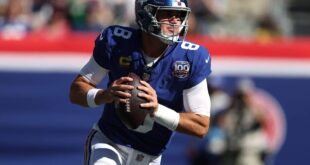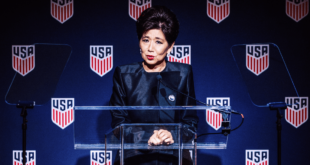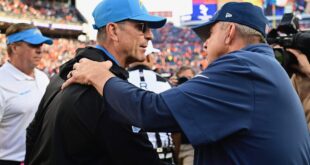Jaxson Dart’s feathered blond hair was tucked under a black hoodie, zipped tightly to his chin. Stone-faced, the quarterback couldn’t stop shaking his head in disbelief.
“I don’t understand how we lost,” he said.
“We should win that game,” coach Lane Kiffin said.
Ole Miss had already suffered a loss to Kentucky. This one landed harder.
“We have followed a plan that was deliberate and intentional to make an effort to be in this first 12-team Playoff,” said Walker Jones, the executive director of The Grove Collective. “That started two years ago.”
It culminated this fall, Jones said, having invested more than $10 million into a roster loaded with talent and highly recruited transfers. Jones said that number likely ranks among the top half of SEC programs.
No. 18 Ole Miss’ goal is still technically in reach, but the 29-26 overtime loss to LSU on Oct. 12 sharply steepened the odds. Among the remaining opponents this season is No. 2 Georgia. The Rebels host Oklahoma this Saturday.
Name, image and likeness, with the NCAA forced by the courts to allow athletes to monetize it in 2021, quickly became the most important fuel for roster building in college sports’ endless arms race. Third-party collectives affiliated with schools became responsible for facilitating it, and Ole Miss was among the schools at the forefront of using the transfer portal to its advantage.

GO DEEPER
College football portal confidential: How tampering, NIL deals and portal chaos happen
Now, even as the way of doing business is changing again amid the House v. NCAA settlement, and with Ole Miss saddled with two losses, it would be easy to decry the roster as money wasted, to point to a program that fell short of its goals.
Jones has the same response to that sentiment he gave to countless donors during two years spent frantically fundraising.
“I don’t know if we’re going to get to the Playoff,” he said, days before the loss to LSU. “But I know how we’re not gonna get there. We’re not gonna get there if we don’t invest in a plan and commit to it.”
Jones was a former Ole Miss team captain and linebacker from 1994 to 1997 who later worked as the director of sports marketing for Under Armour and became an agent. He founded his own business before agreeing to lead Ole Miss’ NIL collective in the middle of 2022.
To educate the fan base and put a face on Ole Miss’ approach to NIL, he convinced athletic director Keith Carter to hold a news conference alongside him and Rebels coaches that fall. Despite alerting the SEC beforehand, that aggressive approach earned Carter a cautionary call from the conference afterward.
Ole Miss, Carter said, is intentional about being aggressive as a means of making up ground between it and competition with bigger budgets and that has had more success traditionally.
“The NIL world and compliance, it’s a lot about risk management now. How far do you think you should go? Can you go? We’ve walked that tightrope pretty well. We’ve been aggressive,” Carter said. “And we’ve done well with some of those calculated risks. And the playing field is leveled some with the new model.”
Jones built relationships with big-money donors and built a subscription platform for fans who could pledge only tens or hundreds of dollars a month.
On the field, Dart was showing promise as a sophomore first-year starter. The winds of change were blowing heavily toward an expanded Playoff, making Ole Miss’ dreams of inclusion more within reach. That December, the 12-team Playoff to launch in 2024 became official.
“We made a decision with coach Kiffin and others that said, ‘Hey, if we’re gonna get in that 12-team Playoff, we need to start now,” Jones said. “I stop short of saying all-in, Playoff-or-bust narrative. But it was an intentional and deliberate approach to put a team together this year to be one of those 12.”
Roster building means managing three worlds: high school recruiting, roster retention and, yes, the portal. The collective must work closely with the coaching staff.
Kiffin quickly agreed to stay mostly uninvolved with how much players were making, Jones said, and The Grove Collective leaves coaches out of financial decisions and negotiations with players. Like most of the more well-funded collectives, The Grove Collective has its own system of metrics and analytics it uses to find valuations for individual players, based on their positions and the team’s needs.
In 2023, Ole Miss signed 23 prospects to land the nation’s No. 2 transfer class, according to 247Sports, building on what Ole Miss had already started when it also landed the No. 2 class in 2022. Only four teams signed more transfers, and Louisiana Tech transfer Tre Harris highlighted the class. Harris leads the nation in receiving and had a highlight touchdown catch in the loss to LSU before being sidelined by an injury.
In 2024, the Rebels added 25 more transfers to sign the nation’s top portal class, with Kiffin embracing his status as the sport’s Portal King. Five-star defensive lineman Walter Nolen came from Texas A&M to highlight the class alongside Florida edge rusher transfer Princely Umanmielen, Alabama corner transfer Trey Amos and South Carolina receiver transfer Antwane Wells Jr.
#PortalKing 😂😂🧩🧩🧩 pic.twitter.com/WJjrNdd3uu
— Lane Kiffin (@Lane_Kiffin) January 31, 2022
In the first year, the collective, Jones said, spent far less on roster retention than in the next year. Key contributors wanted to be paid more for their efforts.
The speed-dating aspect of recruiting the portal meant enlisting team leaders like Dart, Harris and 325-pound, two-way player JJ Pegues to vet players and sign off on the dynamics of bringing transfer players into the program after they visited campus.
The market is settling, Jones said, but any good collective has to be nimble entering each new portal window as players, agents and collectives learn more about how to operate. And the portal works both ways.
Star running back Quinshon Judkins announced in January he was leaving Ole Miss for Ohio State after rushing for more than 2,700 yards and 31 touchdowns the previous two seasons. Ohio State athletic director Ross Bjork told ESPN earlier this offseason the Buckeyes had $20 million to spend on their 2024 football roster.
Jones and The Grove Collective’s efforts in two short years have made waves. Kiffin said in a news conference earlier this year that former Ole Miss coach Hugh Freeze had attempted to pull Jones from his alma mater to help Auburn operate its collective. Jones said he got a chuckle out of it.
In September, Arkansas athletic director Hunter Yurachek called out Arkansas fans at an event and said they needed to grow their numbers to be more like Ole Miss’ collective.
“Nobody loves that Ole Miss is in the top five, right? No. We hate it,” Yurachek told cameras and a crowd gathered at an event for program supporters.
The Grove Collective boasts 6,000 paid subscribers, Jones said, a large portion of whom had never given to Ole Miss before the NIL era and are under 35.
But the shocking home loss to Kentucky and the crushing defeat in Death Valley have caused the wheels underneath the fast start to wobble. What now?
“This isn’t a one-shot wonder. We’re going to continually build rosters that are relevant nationally and in the top 12 and trying to get into the Playoff every year,” Carter said. “If we don’t get in the Playoff this year, it isn’t over. We’re just getting started.”
What that looks like in the future is still unfolding. The House v. NCAA settlement, granted preliminary approval earlier this month, could bring new rules and guidelines to roster management as soon as the summer of 2025.
Some collectives might be brought in-house. Some might partner with schools. Some might stay independent but closely connected to the athletic departments they bolster. Each school will have to decide which model fits it best. The NCAA is looking to monitor “true market value” with a clearinghouse that would vet all NIL deals worth more than $600.
Revenue sharing, a major result of the settlement, with schools paying players directly, is expected to be set at a little more than $20 million next year and will rise as television deals grow more valuable.
“The limited information we have is there will be two buckets of money: the revenue sharing that’s mandated from the settlement and incremental, third-party, market-based NIL,” Jones said. “The second bucket, NIL, will be much harder to police and value, and there isn’t going to be a cap to it. One school might say, ‘We’re gonna spend another $30 million on top of that rev share.’ Another school might say, ‘Well, we only have $5 million we can spend.’”
Jones and The Grove Collective want to make sure Ole Miss is closer to the first group than the second.
(Photo of Ole Miss players Jamarious Brown, left, and Walter Nolen: Jonathan Bachman / Getty Images)
 meganwoolsey Home
meganwoolsey Home



